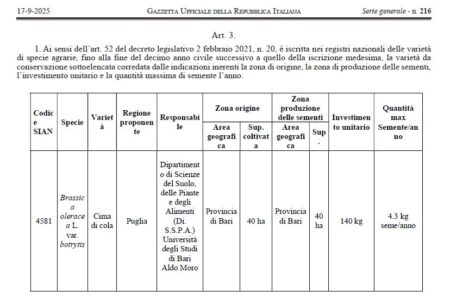- A little more safety for Ukraine’s seeds, thanks to a new genebank.
- A little more safety for Mexico’s native maize, thanks to Pres. Sheinbaum.
- A little more safety for Andean agriculture, thanks to Ecuadorian Indigenous women and Inside Mater in Peru.
- A little more safety for Ischia’s zampognaro bean and Amalfi’s lemons, thanks to local people (and GIAHS).
- A little more safety for Pacific crops, thanks to cryopreservation. Breadfruit next?
- A little more safety for moringa? At least in Africa with all its “opportunity crops”?
Happy birthday MSB!!!
It’s the 25th birthday of Kew’s Millennium Seed Bank (MSB) at Wakehurst in West Sussex.

Understandably, it’s getting a lot of — very well-deserved — coverage. I’ll link to some of the more interesting pieces as they come out over the next few days.
- There’s a podcast hosted by King Charles, no less.
- The Guardian’s podcast is shorter and less cool but ok.
- Cate Blanchett is appearing in that royal podcast, as well as various more plebeian interviews. She’s the MSB’s first ever ambassador. She was recently featured, along with Wakehurst, in House & Garden.
- The Economist has a long piece about seed collecting for the MSB in Madagascar.
- RE:TV has produced a cool video.
- The BBC’s video is shorter and less cool but ok.
- Samara, the International Newsletter of the Millennium Seed Band Partnership, has a very comprehensive anniversary edition.
Here’s to the next 25!
Brainfood: Biodiversity intactness, Landuse change, Drought stress, Crop suitability, Yield variance, Phenotypic data
- Consistent global dataset on biodiversity intactness footprint of agricultural production from 2000 to 2020. Spatial dataset shows how global consumption drives ecological degradation.
- Rapid monitoring of global land change. Spatial dataset shows how in 2023 direct human action and fires caused land use conversion globally over an area the size of California.
- Remote monitoring of plant drought stress with the apparent heat capacity. Spatial dataset can provide early warning of drought. Early warning system for genetic erosion, anyone?
- CropSuite v1.0 – a comprehensive open-source crop suitability model considering climate variability for climate impact assessment. Spatial dataset shows where 48 crops will have the best yields.
- Climate change increases the interannual variance of summer crop yields globally through changes in temperature and water supply. Spatial dataset shows that climate change impacts not just yields but variation in yield from year to year for maize, soybean and sorghum.
- Reassessing data management in increasingly complex phenotypic datasets. Datasets need to be properly managed to be widely used.
‘Cima di cola’ reaches a milestone, apparently
So it seems the first vegetable variety from Puglia has been added to Italy’s Registro nazionale delle varietà da conservazione, or National Register of Conservation Varieties.
The ‘Cima di cola’, a cauliflower variety historically linked to the agricultural tradition of Bari, received official recognition by Ministerial Decree of 9 September 2025, published in the Official Gazette No. 216 of 17 September 2025, which will allow its conservation and promotion also at the commercial level.
I know this because of a post on Facebook from an outfit called Biodiversità delle specie orticole della Puglia (BiodiverSO), translated above. Which unfortunately doesn’t include a link, but does provide this screenshot of Italy’s Official Gazette to prove its point.
Here’s more from the BiodiverSO post.
The inclusion of the ‘Cima di cola’ among conservation varieties is not only an institutional achievement, but also an act of recognition toward those who have preserved its seeds and traditions over the years; a milestone that opens new opportunities for scientific, educational, and gastronomic promotion, which we look forward to sharing with you.
Doubtless.
Which is why I was pretty disappointed to find that the Registro nazionale delle varietà di specie agrarie ed ortive is not actually up to date, so doesn’t yet include ‘Cima di cola’.
Quite apart from not being exactly easy to find. And there was also nothing in the relevant news section, which is actually on a different website, but nevermind.
Anyway, there are 135 “Varietà da Conservazione” registered therein. It’s unclear how to obtain seeds.
LATER: Thanks to Filippo Guzzon for advising me that ‘Cima di cola’ is indeed on the list. I was looking for it under the wrong crop name :(
Brainfood: Taxonomic identification, Niche mapping, Harvest tracking, Drones, Phenomics, Yield analysis
- Review of herbarium plant identification of crop wild relatives using convolutional neural network models. Cool tech helps you figure out which species is which. Now you can map them properly I guess.
- Habitat prediction mapping for prioritizing germplasm collection areas of cowpea (Vigna unguiculata (L.) Walp) in India using BioClim model. Having mapped them, another cool tech helps you figure out where to collect them.
- Harvest Date Monitoring in Cereal Fields at Large Scale Using Dense Stacks of Sentinel-2 Imagery Validated by Real Time Kinematic Positioning Data. And when.
- Drone methods and educational resources for plant science and agriculture. In the field, cool tech could help you find and collect them. And not just that…
- Foliar disease resistance phenomics of fungal pathogens: image-based approaches for mapping quantitative resistance in cereal germplasm. Having collected them, more cool tech helps you evaluate them.
- Machine learning reveals drivers of yield sustainability in five decades of continuous rice cropping. Finally, having evaluated them over many years, cool tech helps you figure out what’s going on.

